Biomechanics Exam 4
1/113
Earn XP
Description and Tags
in class
Name | Mastery | Learn | Test | Matching | Spaced |
|---|
No study sessions yet.
114 Terms
Excitability (irritability)
the capacity to receive and respond to a stimulus
Contractility
The ability to contract or shorten
Extensibility
The ability to be stretched
Elasticity
The ability to return to its original shape after being stretched or contracted
How many individual muscles does the human body have?
more than 600
What is the muscles primary job?
to exert a physical force on other tissues and organs
How is the performance of the muscle tissue under varying loads and velocities determiend????
excitability
contractility
extensibility
elasticity
Agonist
prime mover
Antagonist
action opposite to the agonist
Stabilizers
fixate or stabilize the joint contract isometric
Neutralizer or synergists
Creates a torque to cancel out unwanted action of other muscles
assist or guide
Isometric
A muscular contraction in which the length of the muscle does NOT chanage
Isotonic (concentric and eccentric)
A muscular contraction where the length of the muscle changes
Isokinetic
The muscle changes length during contraction
A constant speed
Common in rehabilitation and research
An Isokinetic Dynamometer is required
Concentric contraction traits
muscle shortens
Net muscle force producing movement are in the same direction as the change in joint angle
The limb movement is termed POSITIVE (joint actions are usually against gravity)
Muscle force > Resistance
Static or Isometric contraction
Muscle tension is generated against resistance to maintain position
No change in muscle length
Muscle force is equal to the resistance
TOTAL TORQUE IS 0 but the muscle is active
Eccentric contraction
muscle lengthens
The muscle force is less than the resistance
Torque by the muscle is in the opposite direction of the rotation of the limbs
Limb movement is termed NEGATIVE (joint actions are usually moving down with gravity or are controlling rather than initiating a motion)
Muscle contraction analysis during activities: Against and towards the gravity exercises
Find out the joint movements during the against-gravity phase
Focus on the against-the-gravity phase to find the main muscles
Primary mover muscles during against the gravity phase do the activity
The against-the-gravity phase is concentric
The direction towards the gravity phase is eccentric
What is another term for muscle cell?
Muscle Fiber
Fascicle
Muscle fibers bundled together in a group of 100 or more
(wrapped by perimysium)
What wraps around the entire muscle?
Epimysium
Sarcomere
A basic contractive unit
Myofilaments (active/contractive component)
Thick: myosin filaments
Thin: actin filaments
Z line / band (between disc)
Actin attached to Z line
Titin
Elastic filament, links myosin filaments to the Z liines
Endomysium
A sheath of connective tissue surrounds each muscle fiber (cell)
Perimysium
A sheath of connective tissue surrounds each fascicle (bundle)
Epimysium
A sheath of connective tissue encases muscles, covers the entire skeletal muscle
Fascia
A sheet of fibrous tissue enclosing of muscles, covers and separates muscles on the outside of the epimysium
Connective tissue
Inside or outside of muscle protect the muscle and can store elastic energy and produce passive force
Order of muscle force transmission
endomysium —> perimysium —> epimysium —> tendon —> bone
Sliding filament and cross bridge theory
Myosin heads split ATP and become reoriented and energized
Myosin heads bind to actin, forming cross-bridges
Myosin heads rotate toward the center of the sarcomere (power stroke)
As myosin heads bind ATP, the cross-bridges detach from actin (detach and relaxation)
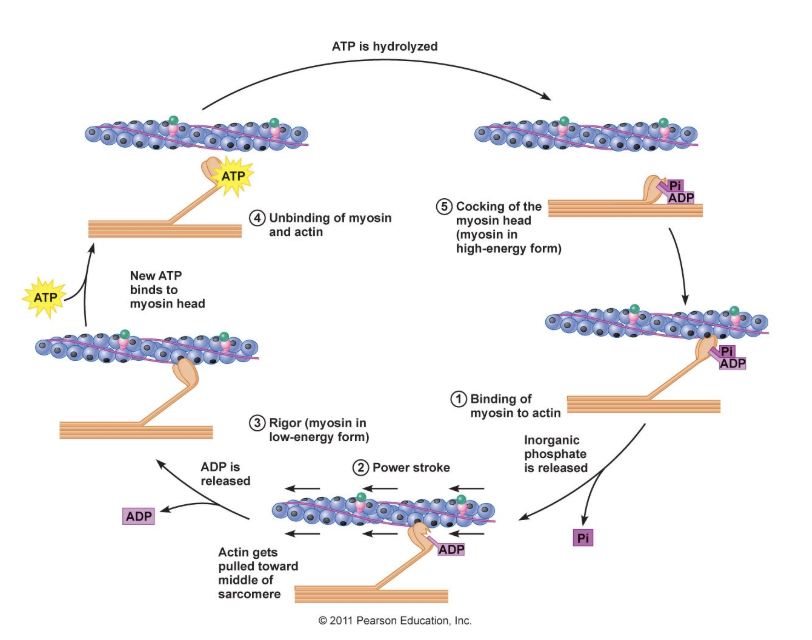
3 components of the Hill Muscle Model
1 contractile component (CC)
2 elastic componentsparallel (PEC)
Series (SEC)
ADD PHOTO???
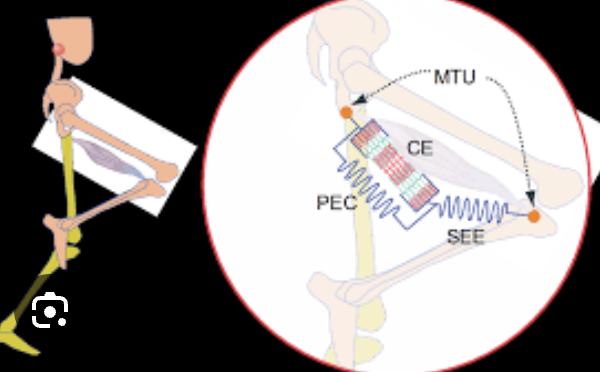
Load
The external forces that act on the body and produce deformations, stresses or displacements in the structure
The strength of a biological material is affected by:
Loading (type, direction, and velocity)
microstructure
age
fluid content
level of activity
Internal force
The force that acts on the inside of the material
shear
bending
torsion
compression
tension
external forces that act on the body are resisted by internal forces that cause deformation
External force
The force comes from the source out of the system (gravitational force or weight)
Stress
When a material is subjected to an external force, a resisting force is set up within the component; this internal resistance force is stress

Strain
The quantification of the deformation of a material

Types of load/stress/strain
Uniaxial
Tensile
Compressioin
Shear
Biaxial & multiaxial stress
Bending (tension + compression)
Torsion: (twisting = tension + compression + shear)
Load
Tensile: The axial load occurs when two opposite forces tend to pull the material apart
Compression: the axial load when two forces tend to push or squash the molecules more tightly together
Shear: A transverse load when two parallel forces tend to slide the material’s molecules past each other
Bending: A biaxial load that is a combination of tensile and compressive loads. acts on 2 sides of the material
Torsion: The multiaxial load that is a combination of two opposite direction torques acting on the material at the same time
Stress
Tensile: axial or normal stress that occurs as a result of a load that tends to pull apart the molecules bonding the object together
Compression: axial stress that occurs as a result of a compressive load
Shear: A transverse stress that occurs as a result of a shear load
Bending: A biaxial stress that occurs as a result of a bending load. One side undergoes tensile and the other is compressive
Torsion: A multiaxial stress that occurs as a result of a torsion load
Strain
Tensile: The axial deformity or lengthening that occurs as a result of a load that tends to pull apart the molecules bonding the object together.
Compression: Axial deformity or shortening that occurs as a result of compressive load
Shear: A transferase deformity that occurs with a change in orientation of adjacent molecules as a result of these molecules slipping past each other.
Bending: the biaxial deformity or curving in the material that occurs as a result of a bending load
Torsion: a multiaxial deformity or twisting that occurs as a result of a torsion load
What components are used in a tensile test?
Tendon, ligament, and muscle
Elastic region
The portion of the curve where the material will return to its original shape if the load is removed
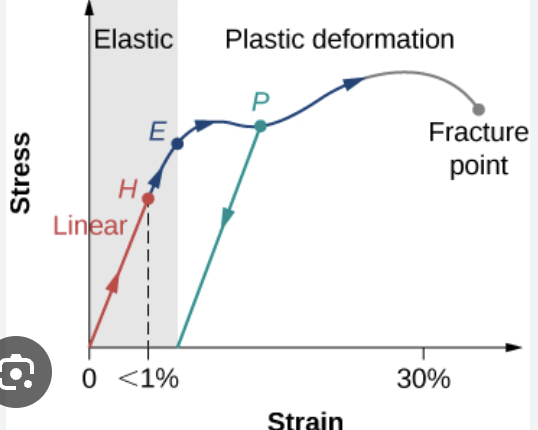
Elastic Behavior
The object will return to its initial shape and size when these forces are removed
Plastic region
The portion of the curve where the material will NOT return to its original shape if the load is removed (some permanent deformation may occur)
Yield point or elastic limit
The point on the stress-strain curve where further stress cause permanent deformation (plastic region)
max stress a material can withstand and still return to it’s original shape after the stress is removed.
Stiffness
The slope of the stress-strain graph, which is the ratio of stress to strain
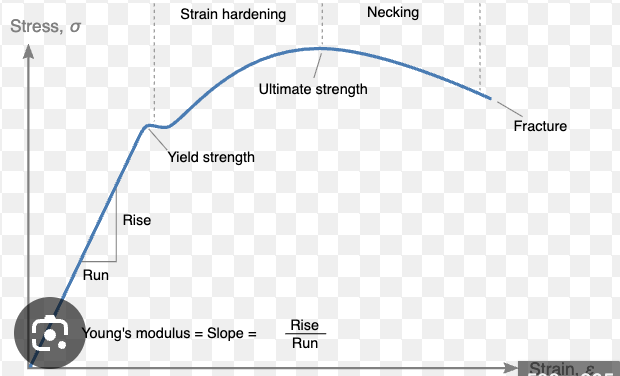
What happens physiologically during a concentric contraction?
An actin-myosin cross-bridge is formed
ATP downgraded to ADP + Pi
Myosin does mechanical work on the Actin, the Myosin arm that rotates, shortening the muscle fiber
As the muscle shortens, the number of attached crossbridges is reduced.
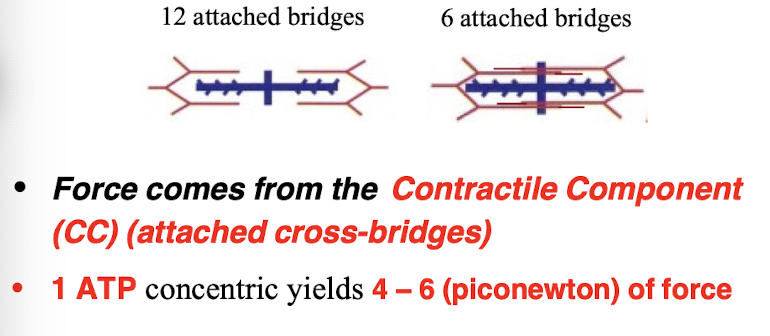
What happens physiologically during a isometric contraction?
An actin-myosin cross-bridge is formed
ATP downgraded to ADP + pi
Myosin attempts to rotate and shorten the fiber
The number of bridges attached remains constant
External force causes the fiber to lengthen
Connective tissue stretch and add more tension
From this lengthened position, the myosin arm rotates and shortens the fiber
Force comes from the contractile component (CC) and the elastic component

What happens physiologically during a eccentric contraction?
An Actin-Myosin cross-bridge is formed
ATP downgraded to ADP + Pi
Myosin attempts to rotate and shorten the fiber
External force causes the fiber to lengthen
Connective tissue stretch and add more tension
Force comes from CC and the Elastic component

Comparison of muscle contractions and force production
Eccentric contraction is capable of greater force output
Concentric contraction generates the lowest force output of the three types
Force is related to the number of cross-bridges formed in the myofibril and the elastic energy stored in the connective tissues
Comparison of muscle actions
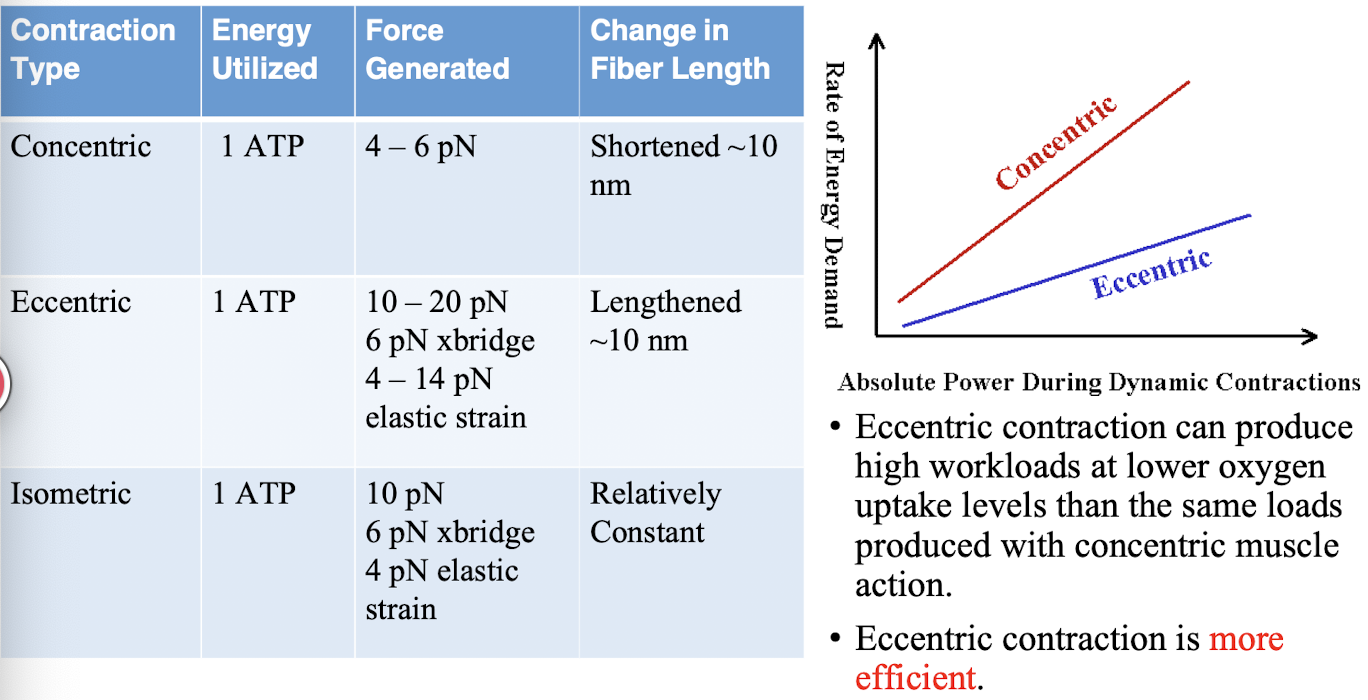
Active Tension
Tension by making a cross-is created bridge and filament sliding
Active component or contractile component: Actin and Myosin filament
Passive Tension
Tension by streteching of the connective tissue
Passive component: sarcolemma, endomysium, perimysium, epimysium, and tendon
Muscle length and tension relationship
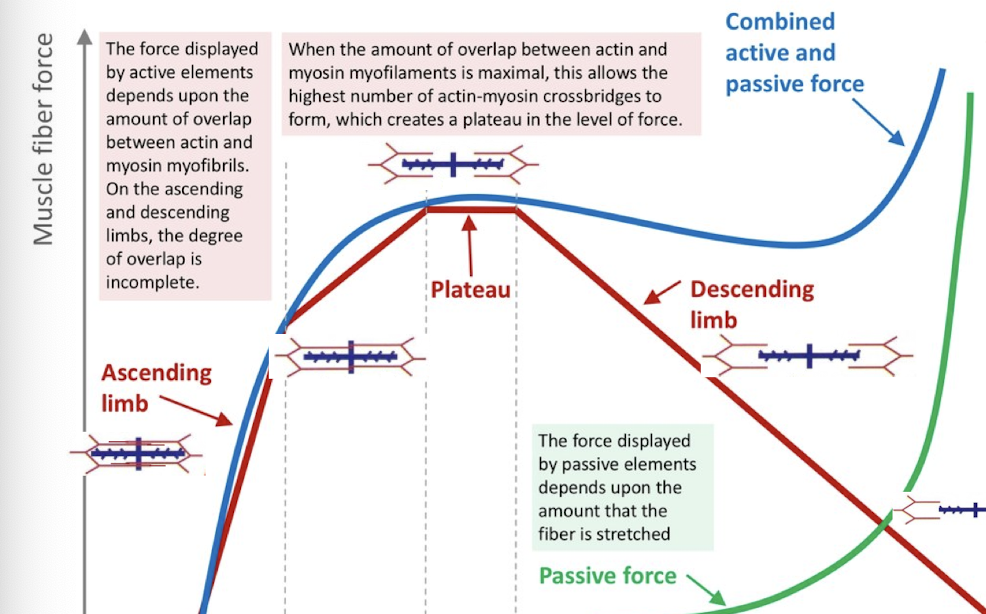
What % can max tension be developed in a whole muscle?
when it’s a little longer than 120% of the resting length
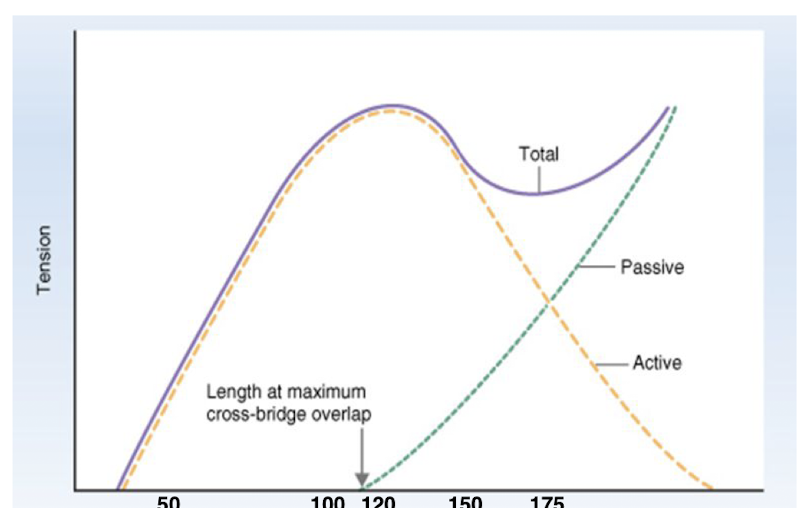
Active Insufficiency
Inability to produce more force when the muscle is too short usually in multi-joint muscles
Passive insufficiency
Inability to produce more force when the muscle is too extended, usually in multi-joint muscles
Force-length relationship in training
our muscles have an ideal angle where they produce the greatest tension
The length is usually the midpoint of the range of motion
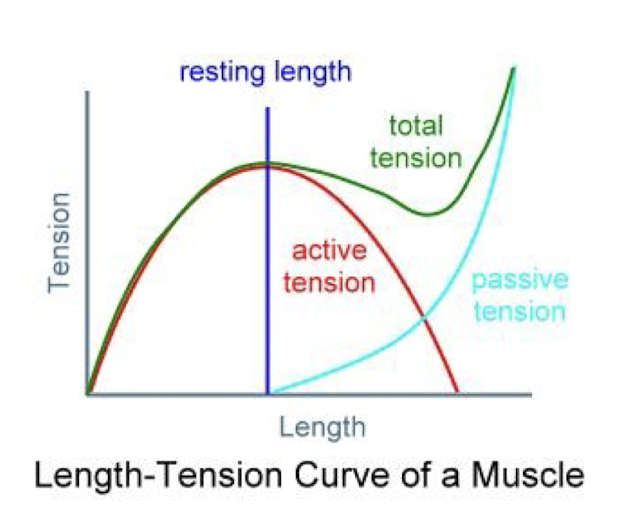
How to train to optimize force-length (designing programs)
The muscles must train in their FULL range of motion and in a range close to the optimal length
The optimal length will get involves active components (Actin and Myosin)
The training in a longer length (full range of motion) involves the passive components (connective tissue)
Single muscle fiber force production is greater during stretch training when the passive elements can contribute to tensile force in the contraction
What is the “extra force” provided by?
Titin!!!!
When the muscle is elongated to long lengths titin senses the mechanical loading that it is exposed to, and triggers longitudinal fiber hypertrophy to occur
Force and velocity relationship
Eccentric > Isometric > Concenetric
The max muscle force or tension is related to the velocity of shortening of the muscle
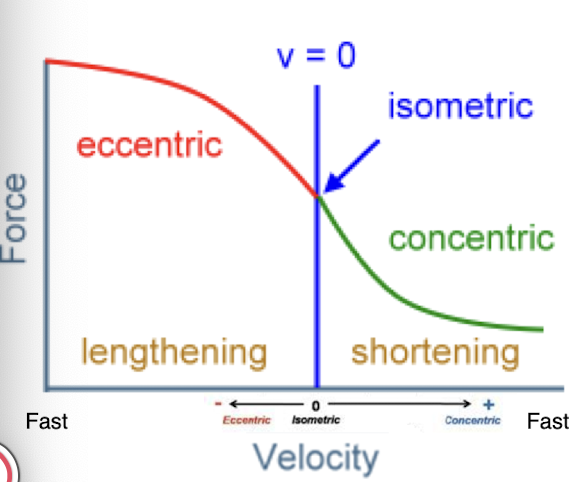
V=0 means no movement
Concentric Cross-bridge cycle (3 steps)
Cross bridge, Pull (power stroke), Detach
A high force at a slower velocity because of the slower detachment rate —> more attached cross-bridge
A low force at fast velocity because of a higher detachment rate —> less attached cross bridge
Ability to produce more force during slower motion:
4 pN (piconewton) from myosin motor for fast velocity
5 pN from myosin motor for slow velocity
Eccentric Cross-bridge cycle (3 steps)
*The connective tissues stretched, adding more tension
External force causes the fiber to lengthen, storing elastic energy in connective tissues.
Muscle-tendon unit is a viscoelastic material
The viscoelastic response of the musculotendonous unit means that a slow stretch will create less passive tension; a faster stretch will create more passive tension
10 pN for slow velocity
20 pN for fast velocity
Force-velocity relationship (graph)
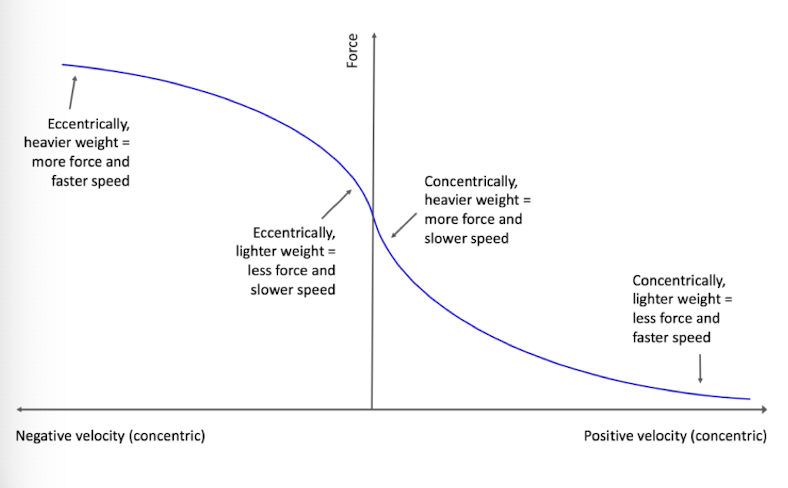
concentric - against gravity
eccentric - same position but WITH gravity
Different tempos during 4 phases of a repition
Eccentric rep (lowering the weight)
Isometric rep (midpoint - bottom of the rep)
Concentric rep (lifting the weight)
Isometric rep (starting point)
Which tempo is best? - Concentric
Fast contraction: less time under tension but recruits more and larger motor units
Slow contraction: higher force by individual muscle fibers but recruits less number and smaller motor units
Which tempo is best? - Eccentric
Fast contraction: Involve more passive force by connective tissues and less active force, stimulate greater increase in fiber length
Slow contraction: High time under tension and recruits more and larger motor units
Which tempo is best? - Isometric
Velocity doesn’t matter
Tempo shows the time under tension
What does high levels of tension during strength training at the force end of the force-velocity relationship stimulate?
Specific “tension-related” adaptations that lead to greater maximum strength.
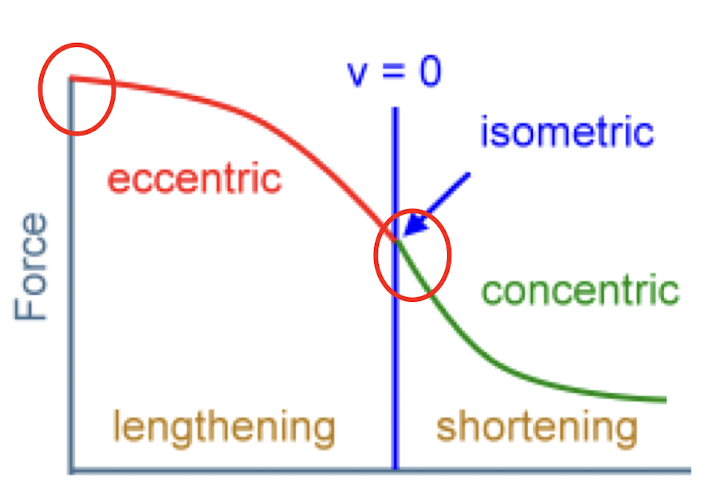
What does high levels of tension during strength training at the VELOCITY end of the force-velocity relationship stimulate?
Specific “velocity-related” adaptations that lead to an improved ability to produce force at high speeds
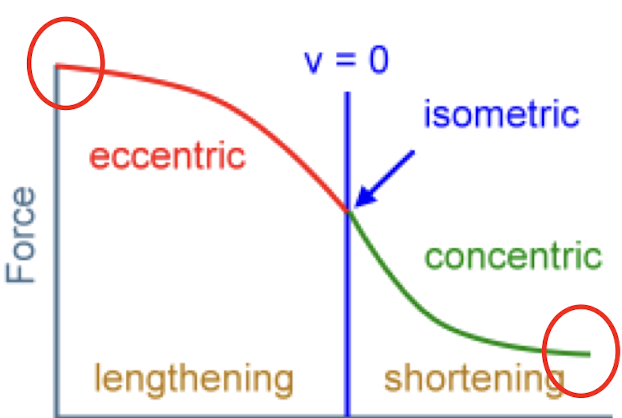
same output (low vs high gear)
Low gear - small forces on the pedals but spin the crank fast
High gear - exert large forces spin crank very slowly
The best gear: allows to spin the crank at the moderate speed and keep muscle’s velocity of shortening near to max power (30-33% velocity of shortening)
Power equation
Force x velocity = work/time
The power output of a muscle is the tensile force produced by the muscle times the velocity of shortening of the muscle
Work equation
Force x Displacement
In joints: work = torque x ROM (J)
What is torque and ROM during concentric contraction if a higher velocity?
Lower torque
Lower ROM (usually)
Exteroceptors
Responses to stimuli come from outside of the body
Five senses: sight, hearing, taste, smell, and touch
Interoceptors
Responses to stimuli come from within the body
Proprioceptors
Specialized sensory receptors that are located within joints, muscles, and tendons
Muscle spindle: muscle length
GTO
Reflexes
Involuntary response to stimuli, it is under spinal cord control
Muscle spindle
SKM sensory receptors within the body of a muscle
Primarily detect:
Changes in the length of the muscle
Axial alignment and limb position
Velocity of the changes
Muscle spindles have both sensory and motor components
Stretch reflex (of muscles spindle)
Plays an important role in regulating the contraction of muscles by activating motor neurons to resist muscle strength
Muscle spindle detects the stretch of a muscle or muscles, relative changes in length, and velocity of changes
Causes of stretch reflex
Efferent impulses to alpha motor neurons: contraction in muscle after stretching (resist against stretch)
Efferent impulses to antagonist muscles: inhibit contraction of the antagonist muscle (reciprocal inhibition)
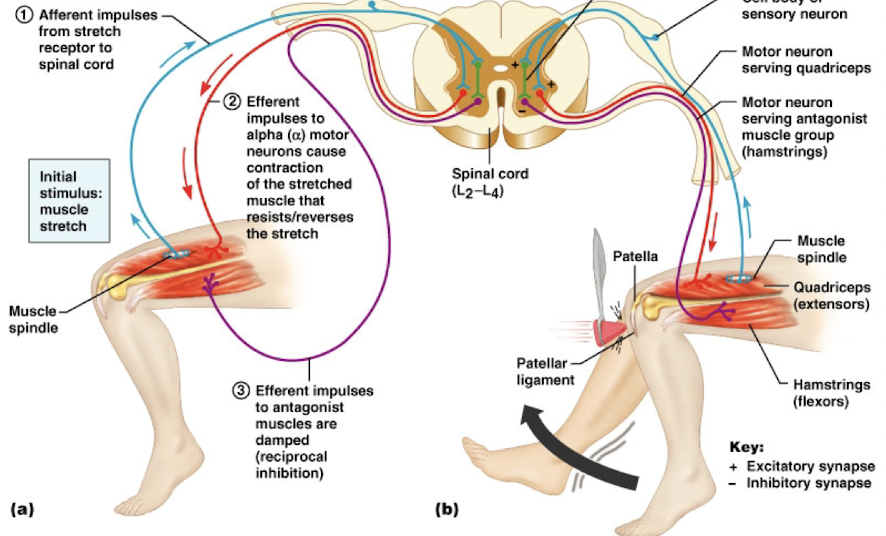
Stretch-shortening cycle (plyometric exercises)
The stretch-shorten cycle: an eccentric contraction followed by an immediate concentric contraction
Additional force is produced during the concentric phase of a stretch - shorten cycle
The less time between the stretching and contraction (Amortization phase) = greater force
What does plyometric training involve?
Short, intense bursts of activity that target fast-twitch muscle fibers in the lower body. These fibers help generate explosive power that increases speed and jumping height
Plyometric exercises
Conditioning protocol that utilizes pre-stretching
single leg bounds, depth jumps, stair hopping
What is the extra force attributed to in the stretch-shortening cycle?
Stored elastic energy (tendon, and titin) (80% of total energy)
Faster stretching: higher stored elastic energy (velocity-dependent behavior in viscoelastic tissues)
Faster contraction: Less wasting in stored elastic energy (use it or lose it)
Eccentric phase pre-stretches the muscle, so the concentric phase begins at a longer length and so a higher force (force-length relationship)
Eccentric phase elicits a stretch reflex (Just 20%)
Increase activation in agonist muscles
Increase relaxation in antagonist muscles
Golgi tendon organ
Report the muscle tension with the tendon
Protects the muscle from rupturing
Response:
Inhibitory: turn off the muscle
Proprioceptive Neuromuscular Facilitation
Technique of combining passive stretching and isometric contraction to achieve maximum static flexibility
PNF was initially developed as a method of rehabilitation
A muscle group is passively stretched 5- 10s (muscle spindle activation: contraction on the muscle and relaxation on the antagonist)
Isometric contraction against resistance 5- 10s (increase the tension on the muscle and GTO activation: a powerful relaxation on the target muscle groups)
Passively stretched again (improve the flexibility)
The two nervous system mechanisms to control muscle force
Recruitment and size of stimulation
Frequency of stimulation
Recruitment and size of stimulation
Recruitment: muscle force depends upon the number of fibers that are stimulated ( The number of active motor units)
Recruitment occurs generally in an orderly sequence from small to large motor units.
Frequency of stimulation
One mechanism to control muscle force is to increase the Rate of Stimulation (firing rate)

Twitch (frequency of stimulation)
Single, brief contraction
Not a normal muscle function
Tetanus (frequency of stimulation)
Summing of contractions
One contraction is immediately followed by another
The effects are added
Unfused tetanus (frequency of stimulation)
Incomplete tetanus
Some relaxation occur between contractions
The results are summed
Fused (frequency of stimulation)
Complete tetanus
No evidence of relaxation before the following contractions
The result is a sustained muscle contraction
Action Potential
The change in electrical potential associated with the passage of an impulse along the membrane of a muscle cell or nerve cell
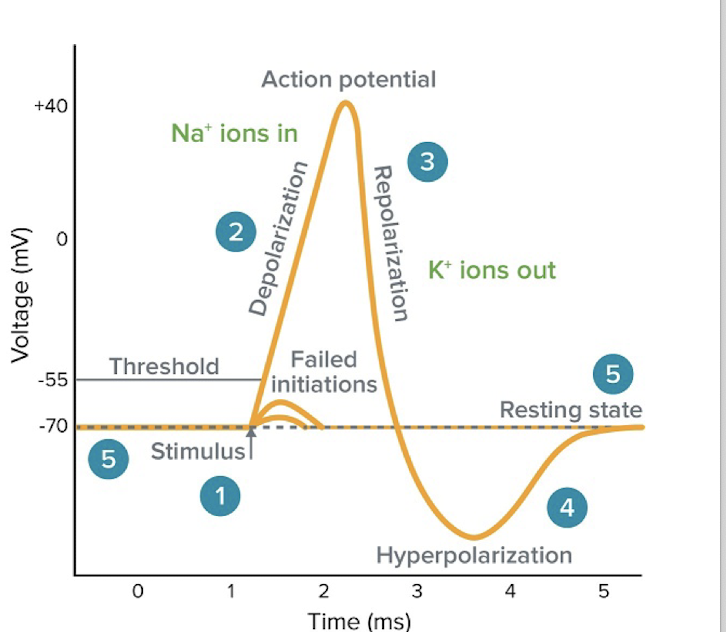
Resting membrane potential (RMP)
Potential difference exists across the sarcomere
What do EMGs measure?
The electrical activity of muscles when they’re at rest and when they’re being used. Electromyography detects the electrical potential generated by muscle cells when these cells contract and relax.
Surface EMG
most reliable and applicable technique between other type in kinesiology and exercise science